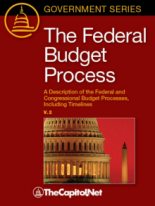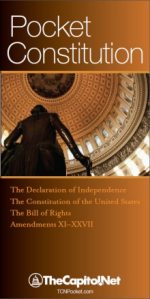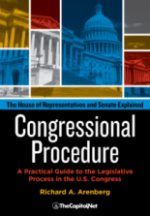From the Congressional Glossary – Including Legislative and Budget Terms
Balanced Budget and Emergency Deficit Control Act of 1985, aka Gramm-Rudman-Hollings (GRH)
President Reagan’s Remarks to Congressional Supporters for a Balanced Budget on December 18, 1985
Also known as the Deficit Control Act, originally known as Gramm-Rudman-Hollings. Among other changes to the budget process, the law established “maximum deficit amounts” and a sequestration procedure to reduce spending if those targets were exceeded. The Deficit Control Act has been amended and extended several times–most significantly by the Budget Enforcement Act (BEA) of 1990. The sequestration and enforcement mechanisms expired or became ineffective at the end of fiscal year 2002.
Among other things GRH provided:
Part A: Congressional Budget Process – Amends the Congressional Budget and Impoundment Control Act of 1974 to prescribe maximum Federal budget deficits for each of fiscal years 1986 through 1991 providing for the incremental reduction of the deficit to zero by FY 1991. Requires Old Age, Survivors and Disability Insurance (OASDI) revenues and expenditures to be included in the calculation of deficits. Requires the receipts, revenues, disbursements, budget authority, and outlays of each off-budget Federal entity for a fiscal year to be included in total budget authority, total budget outlays, and total revenues and the amounts of budget authority and outlays set forth for each major functional category of the budget for such fiscal year. Requires amounts paid by the Federal Financing Bank to purchase loans made or guaranteed by a Government entity to be treated as outlays of such entity.
. . .
Requires the Congress to complete action on an annual concurrent resolution on the budget on or before April 15 of each year. Requires such budget resolution to set forth appropriate budgetary levels for each fiscal year beginning on October 1 of such year and planning levels for each of the two ensuing fiscal years. Provides that such resolution may also set forth: (1) reconciliation directives; and (2) the calendar year in which the Congress believes the unemployment goals of the Employment Act of 1946 should be achieved.
. . .
Part B: Budget Submitted by the President – Requires submission of the President’s budget to the Congress by the first Monday after January 3 of each year. Requires the annual budget submitted by the President to be prepared on the basis of the best estimates available so as to ensure that the deficit set forth for a fiscal year shall not exceed the applicable maximum deficit amount.
In the face of ever increasing budget deficits, in 1985 Congress enacted the Balanced Budget and Emergency Deficit Control Act. This Act is known as Gramm-Rudman-Hollings, named after the Senate authors of the original bill (Senators Phil Gramm of Texas, Warren Rudman of New Hampshire, and Ernest F. Hollings of South Carolina).
Gramm-Rudman-Hollings established “maximum deficit amounts.” If the deficit exceeded these statutory limits, the President was required to issue a sequester order that would reduce all non-exempt spending by a uniform percentage. Gramm-Rudman-Hollings also made a number of changes to the congressional budget process to enforce maximum deficit amounts and to strengthen congressional budget enforcement procedures. The most significant change was to increase the margin necessary to waive certain points of order from a simple majority vote to a three-fifths margin in the Senate.
Budget Chef Presents: How to Balance the Budget W/O Raising Taxes!
In July of 1986 in Bowsher v. Synar (478 U.S. 714, 1986), the Supreme Court held that the provision of Gramm-Rudman- Hollings, which vested certain powers in the General Accounting Office [GAO, now the Government Accountability Office], violated the separation of powers doctrine of the Constitution. This was due to the Office’s (a creature of Congress) role in implementing sequester orders. The Court found it unacceptable from a constitutional perspective for Congress to vest in a congressional entity a duty of the executive branch–the responsibility for executing a law. In 1987, Congress enacted the Balanced Budget and Emergency Deficit Control Reaffirmation Act which corrected the constitutional flow in Gramm-Rudman-Hollings by assigning all the sequester responsibilities to the Office of Management and Budget (OMB). OMB is part of the executive branch. The 1987 Act also extended the system of deficit limits through fiscal year 1992.
Despite Gramm-Rudman-Hollings procedures, the deficit continued to increase. In the spring of 1990, it became clear that the deficit was going to exceed the Gramm-Rudman’s maximum deficit limit by nearly $100 billion. Later that year, OMB estimated that a sequester of $85 billion would be necessary to eliminate this excess deficit amount. Because Congress had exempted most of the budget from the sequester process, such a sequester order was going to require a 32 percent reduction in defense programs and a 35 percent reduction in non-defense programs. To respond to growing deficits, President George H. W. Bush and the congressional leadership agreed to convene negotiations on the budget in May of 1990. Six months later, President Bush signed into law the Omnibus Budget Reconciliation Act of 1990, which represented the budget agreement negotiated between the Bush Administration and Congress.
Title XIII of this reconciliation act, the Budget Enforcement Act, constituted the enforcement provisions of the agreements. The 1990 Budget Enforcement Act (BEA) effectively replaced the Gramm-Rudman-Hollings system of deficit limits with two independent enforcement regimens: caps on discretionary spending and a pay-as-you-go requirement for direct spending and revenue legislation. The BEA also provided for enforcement by both the congressional and executive branch of the discretionary caps and the pay-as-you-go requirement.
More
- Senate Budget Committee
- House Committee on the Budget
- 1985 Balanced Budget and Emergency Deficit Control Act – Slaying the Dragon of Debt, The Bancroft Library, University of California, Berkeley
- Gramm-Rudman-Hollings Balanced Budget Act – Wikipedia
- Balanced Budget and Emergency Deficit Control Act of 1985, Bill Summary – Congress.gov
- “Rewriting the Fiscal Constitution: The Case of Gramm-Rudman-Hollings,” by Kate Stith (1988), Yale Law Faculty Scholarship Series. Paper 1266.
- “Seven Reforms to Balance the Budget,” by Stephen Moore, Cato Policy Report, July/August 1996
- “Sequestration: Gramm-Rudman’s Potent Weapon for Spending Restraint,” by Daniel J. Mitchell, Cato Policy Analysis no. 119, April 24, 1989
- “Gramm-Rudman-Hollings: Potential Economic Effects of Meeting Deficit Targets,” CRS Issue Brief IB87059 (6-page PDF
 )
) - “Explanation of the Balanced Budget and Emergency Deficit Control Act of 1985 — Public Law 99-177 (The Gramm-Rudman-Hollings Act),” CRS Report 85-1130 (39-page PDF
 )
) - “Congressional Oversight of Judges and Justices,” CRS Report RL32926 (39-page PDF
 )
) - “The Federal Budget Process,” CRS Report 98-721 (38-page PDF
 )
) - “The Magnitude of Changes That Would Be Required to Balance the FY2011 Budget,” CRS Report RS21939 (10-page PDF
 )
) - “The Balanced Budget Act of 1997,” CRS Report 97-635 (12-page PDF
 )
) - “Baselines and Scorekeeping in the Federal Budget Process,” CRS Report 98-560 (6-page PDF
 )
) - “Budget Process and Enforcement,” Parliamentary Boot Camp (4-page PDF
 )
) - “Federal Deficits, Growing Debt, and the Economy in the Wake of COVID-19,” CRS Report R46729 (24-page PDF
 )
) - “A National Disgrace: The federal budget process threatens America’s future.” By John Steele Gordon, City Journal, February 19, 2021
Courses
- Congressional Operations Briefing – Capitol Hill Workshop
- Drafting Federal Legislation and Amendments
- Writing for Government and Business: Critical Thinking and Writing
- Custom Training
- Congressional Operations Poster, with Federal Budget Process Flowchart
- Federal Budgeting, a Five-Course series on CD
- Congress, the Legislative Process, and the Fundamentals of Lawmaking Series, a Nine-Course series on CD
Publications

The Federal Budget Process 2E

Pocket Constitution

Citizen’s Handbook to Influencing Elected Officials: A Guide for Citizen Lobbyists and Grassroots Advocates

Congressional Procedure
CongressionalGlossary.com, from TheCapitol.Net
For more than 40 years, TheCapitol.Net and its predecessor, Congressional Quarterly Executive Conferences, have been teaching professionals from government, military, business, and NGOs about the dynamics and operations of the legislative and executive branches and how to work with them.
Our custom on-site and online training, publications, and audio courses include congressional operations, legislative and budget process, communication and advocacy, media and public relations, testifying before Congress, research skills, legislative drafting, critical thinking and writing, and more.
TheCapitol.Net is on the GSA Schedule, MAS, for custom on-site and online training. GSA Contract GS02F0192X
TheCapitol.Net is now owned by the Sunwater Institute.
Teaching how Washington and Congress work ™

